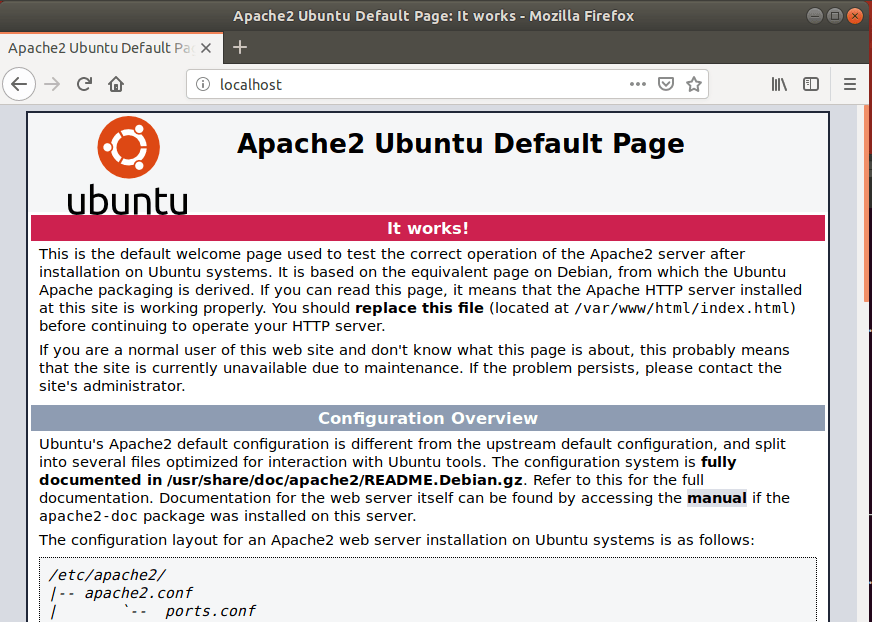For the uninitiated, ChurchCRM is an open-source CRM software built for churches that can serve as a strong alternative to the popular CRM systems in use today. If you own a church and you want a CRM platform, then ChurchCRM might just be what you want. It comes with an intuitive dashboard that provides a quick view of your members, Sunday school activities, financial modules, and more. For more about ChurchCRM, please check its homepage. To get started with installing ChurchCRM, follow the steps below:
Install Apache2 HTTP Server
ChurchCRM requires a web server and the Apache2 HTTP server is the most popular open-source web server available today. To install the Apache2 server, run the commands below: After installing Apache2, the commands below can be used to stop, start and enable the Apache2 service to always start up with the server boots. Now that Apache2 is installed. to test whether the web server is working, open your browser and browse to the URL below. If you see the page above, then Apache2 is successfully installed.
Install MariaDB Database Server
ChurchCRM also requires a database server to store its content. If you’re looking for a truly open-source database server, then MariaDB is a great place to start. To install MariaDB run the commands below: After installing MariaDB, the commands below can be used to stop, start and enable the MariaDB service always to start up when the server boots. Run these on Ubuntu 16.04 LTS Run these on Ubuntu 18.10 and 18.04 LTS Next, run the commands below to secure the database server with a root password if you were not prompted to do so during the installation. When prompted, answer the questions below by following the guide.
Enter current password for root (enter for none): Press the Enter Set root password? [Y/n]: Y New password: Enter password Re-enter new password: Repeat password Remove anonymous users? [Y/n]: Y Disallow root login remotely? [Y/n]: Y Remove test database and access to it? [Y/n]: Y Reload privilege tables now? [Y/n]: Y
Now that MariaDB is installed, to test whether the database server was successfully installed, run the commands below. type the root password when prompted. If you see a similar screen as shown above, then the server was successfully installed.
Install PHP 7.2 and Related Modules
ChurchCRM is a PHP-based platform and for now, only PHP 7.2. PHP 7.2 may not be available in Ubuntu default repositories. To run PHP 7.2 on Ubuntu 14.04, you may need to run the commands below: Then update and upgrade to PHP 7.2 Next, run the commands below to install PHP 7.2 and related modules. After installing PHP 7.1, run the commands below to open the PHP default configuration file for Apache2. The lines below are a good setting for most PHP-based CMS. Update the configuration file with these and save. Every time you make changes to the PHP configuration file, you should also restart the Apache2 web server. To do so, run the commands below: Now that PHP is installed, to test whether it’s functioning, create a test file called phpinfo.php in the Apache2 default root directory. ( /var/www/html/) Then type the content below and save the file. Next, open your browser and browse to the server’s hostname or IP address followed by phpinfo.php You should see the PHP default test page.
Create ChurchCRM Database
Now that you’ve installed all the packages that are required for ChurchCRM to function, continue below to start configuring the servers. First, run the commands below to create a blank ChurchCRM database. To log on to the MariaDB database server, run the commands below. Then create a database called churchcrm Create a database user called churchcrmuser with a new password Then grant the user full access to the database. Finally, save your changes and exit.
Download ChurchCRM Latest Release
The churchCRM community edition can be downloaded from its download page here. On the Ubuntu terminal, run the commands below to download, then extract to its root directory. Then run the commands below to set the correct permissions for the ChurchCRM root directory and give Apache2 control.
Configure Apache2
Finally, configure the Apahce2 site configuration file for ChurchCRM. This file will control how users access ChurchCRM content. Run the commands below to create a new configuration file called churchcrm.conf Then copy and paste the content below into the file and save it. Replace the highlighted line with your domain name and directory root location. Save the file and exit.
Enable the ChurchCRM and Rewrite Module
After configuring the VirtualHost above, enable it by running the commands below Then open your browser and browse to the server domain name. You should see the ChurchCRM setup wizard complete. Please follow the wizard carefully. Then follow the on-screen instruction. Validate that all requirements are met and continue During the setup, you’ll be prompted to enter a Root Path For the tutorial, we’re going to be accessing the portal from our main domain ( http://example.com ). Leave blank. Next, type in the database name, username, and password, then complete the setup After that, you should be able to log in with the credentials below: Username: Admin Password: changeme Conclusion: You have successfully learned how to install the ChurchCRM platform on Ubuntu. You may need to configure additional settings, but the steps above give you a basic starting point. If you find errors with the steps above, please comment below: You may also like the post below:



